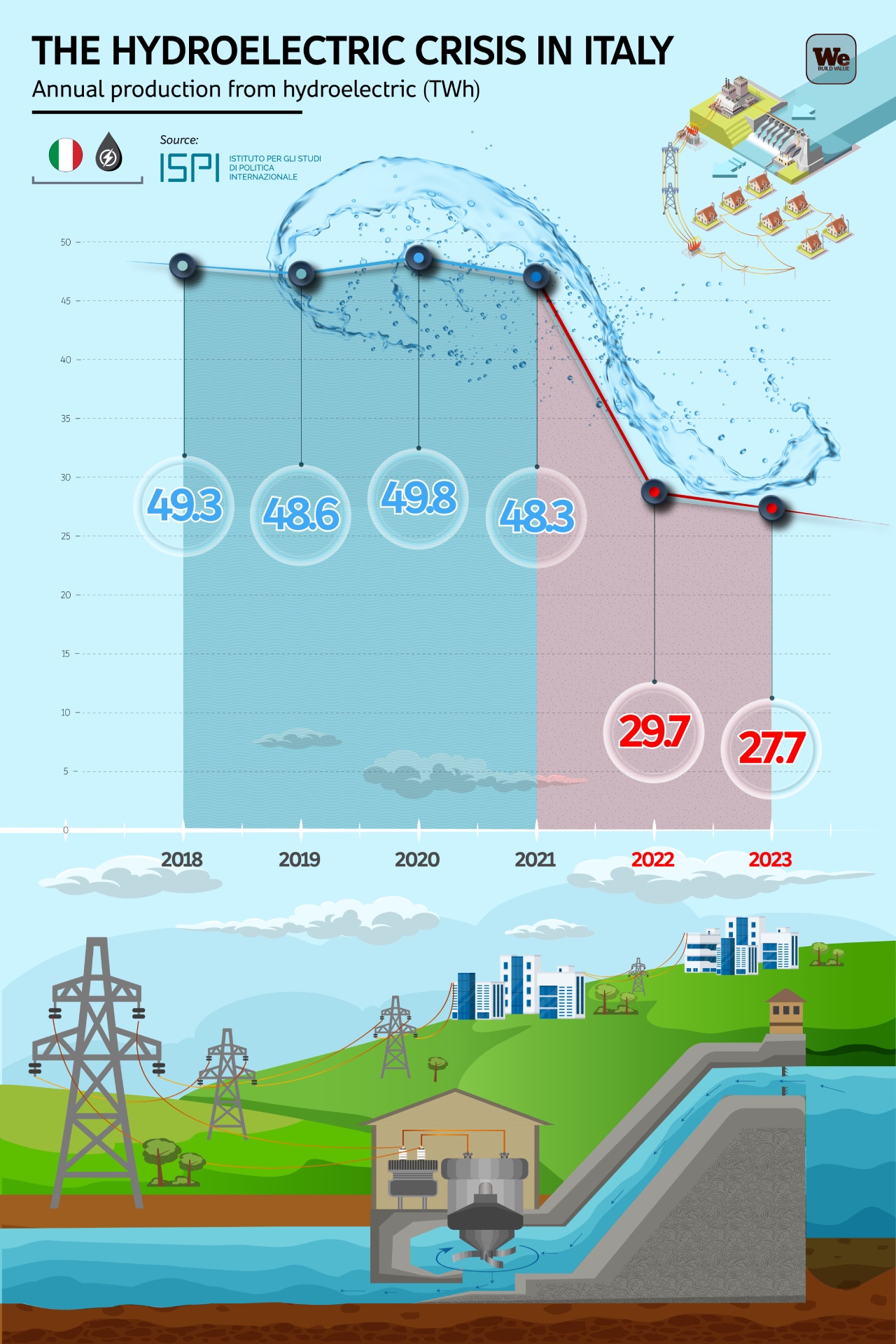The floods of last year that severely hit Emilia-Romagna are not enough to change the course of recent history. It’s a history that reflects one of the most severe drought periods for Italy in over a century, a country traditionally rich in water but now suffering the repercussions of a chaotic climate.
And drought, the scarcity of water, represents a critical factor for the functioning of hydroelectric plants, the first source of clean energy in Italy. When dam basins dry up and the water channels that power power plant turbines lose power, the energy produced is reduced. This is what has happened in recent years, precisely due to the effects of water shortages.
Already in 2023 (prior to this terrible winter where snow was barely seen on many mountain ranges in the country), the Cima Foundation certified that snow cover was the lowest in the past 11 years. Not only that: 2022 boasts the unfortunate record of the worst drought in the last 70 years, with inevitable effects triggering processes of micro-desertification, naturally connected to water scarcity.
But in this period of great international uncertainty, water scarcity is also linked to another equally concerning phenomenon: the volatility of energy supplies. The war in Ukraine as well as the Middle Eastern crisis have reopened the energy question, where water, used within hydroelectric plants, can play a decisive role.
This is why investing in the redevelopment of water networks, as well as in the modernization of hydroelectric plants and dams, becomes the main path to best respond to the water crisis.
Hydroelectric plants in Italy in search of water
Water scarcity, combined with low investments in the sector, has contributed to the reduction in energy production from hydroelectric plants. According to analyses conducted by Ispi based on Terna data (the company that manages the country’s power grid), in 2023, 27.7 TWh of energy was produced from hydroelectric plants (approximately 10% of the total energy produced in Italy in a year), slightly less than the 29.7 in 2022, but significantly lower than the 48.3 in 2021.
Between 2018 and 2021, the average energy produced by hydroelectric plants was around 49 TWh, 30% higher than the results of the last two years. Furthermore, according to Ispi’s projections, even in 2024, production from such plants will not exceed 27.7 TWh.
To understand the impact of these data on the total energy produced in the country, it’s necessary to consider that under normal conditions, Italy produces about 15% of all its electricity from hydro sources. The collapse recorded in the last two years has reduced this percentage to 9%, consequently significantly reducing the percentage of renewable energy on the total produced by the country. If on average 35% of Italian energy production comes from renewables, the decline in hydroelectric power has brought the share of green energy to 30%, a step back from the commitment of many European countries aiming to achieve zero emissions by 2050.
The investments needed for green development
Hydroelectric power thus remains an essential energy source for Italy, as well as a formidable tool for pursuing clean energy goals. Some of the world’s most advanced countries are investing in this direction, with the support of the Webuild Group, historically one of the global leaders in hydro infrastructure. This is the case, for example, of Australia, which is building Snowy 2.0 with Webuild, the largest energy production and storage facility in its history, powered by the waters of the Snowy Mountains.
To bridge its gap – at least according to the study “Water: actions and investments for energy, people, and territories”, conducted by The European House – Ambrosetti in collaboration with A2A last September – Italy should invest €48 billion in the sector, mainly to be allocated to existing system efficiency interventions. The investment would have a positive impact not only from an energy perspective but also economically. Improving the existing water network would allow for a water saving of 9.5 billion cubic meters, ensuring positive economic repercussions for the national economy amounting to €77 billion.
The construction of hydro-pumped schemes, following what Australia is doing with Snowy 2.0, i.e., plants that utilize water to produce and store energy, would be the fastest way to increase the weight of clean sources within Italian energy production, while simultaneously reducing the negative impacts of the chaotic climate.


